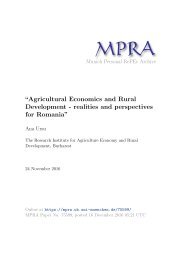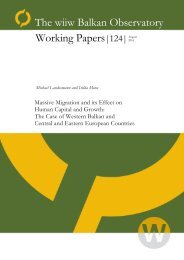You also want an ePaper? Increase the reach of your titles
YUMPU automatically turns print PDFs into web optimized ePapers that Google loves.
establishment of some networks of temporary labor migration. Access to the<br />
networks of ethnic Germans mediated the access of Romanians to temporary<br />
labor in Germany (Michalon 2003b: 21). For example, in Baden Württemberg and<br />
Bavaria, some Transylvanian Saxons used networks in Romania to bring workers<br />
into the German constructions sector (Michalon 2003b); when coming back to<br />
Romania, Germans expanded their networks to ethnic Romanians.<br />
In the first years after 1989, there was also a strong wave of Romanian<br />
citizens who requested political asylum predominantly in Germany. These<br />
asylum seekers were the second largest category of migrants from Romania<br />
between 1990 and 1994. At the beginning of the 1990s, Romanians moved to<br />
Germany either irregularly, crossing the borders between Poland, Czech<br />
Republic and Germany (Reyniers 2003: 57), 16 or received invitations from the<br />
Romanian Germans (Diminescu 2003:16). Once in Germany, they filled in<br />
requests for political asylum. Between 1990 and 1993 Romanian citizens formed<br />
the largest group among the applicants for political asylum. During that period,<br />
Romanian citizens applied for asylum in Western Europe (Fassmann and Münz<br />
1994: 532-533) out of which Germany received the largest numbers: there were<br />
about 60,000 applicants in 1992 and more than 140,000 applicants in 1993 17 .<br />
Table 1: Number of applications for political asylum in Germany,<br />
Romanian citizens, 1990-1999<br />
1990 1991 1992 1993 1994 1995 1996 1997 1998 1999<br />
11,191 27,089 57,464 146,738 21,424 10,274 3,168 1,672 917 537<br />
About half of these applicants were Roma (Reyniers 2003) who<br />
complained about increasing discrimination in Romania. Nevertheless, in 1993<br />
Romania was considered a safe country and further applications were denied<br />
(Weber et al. 2003). In order to enforce the law, Germany signed a bilateral<br />
16 For example, in 1991, 8,500 Romanian citizens were apprehended at the German-Polish<br />
border and another 4,500 between 1st of January and the 15th of March 1992. About 12 450<br />
Romanian citizens tried to enter Germany in the first six months of 1992 (Reyniers 2003: 58).<br />
17 Source: Interview BAMF.<br />
8




